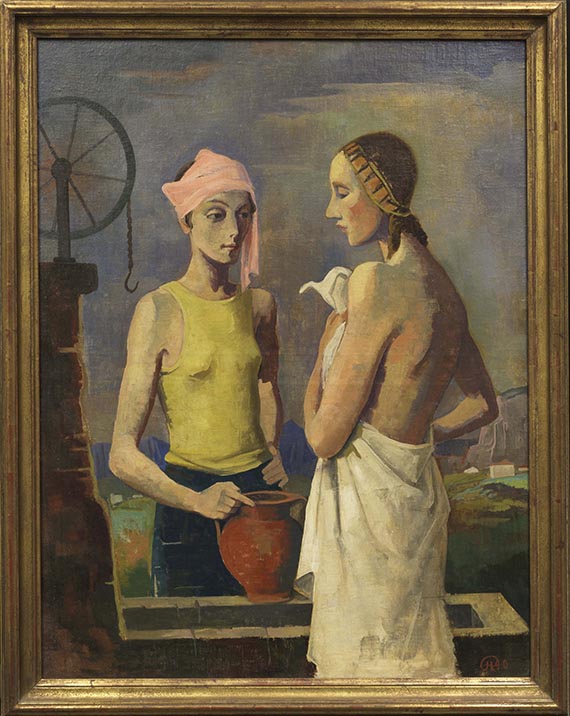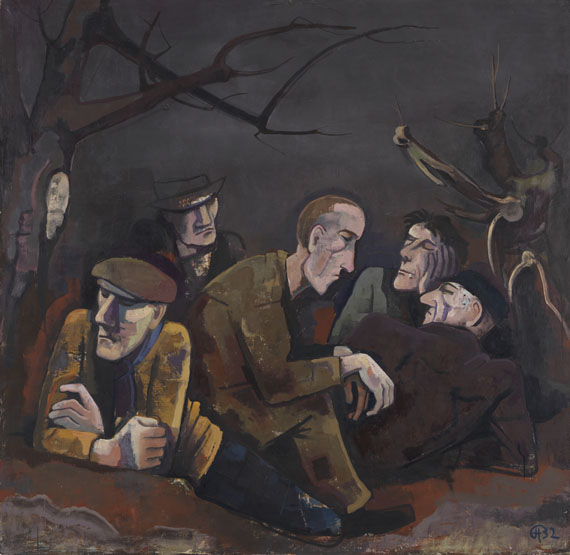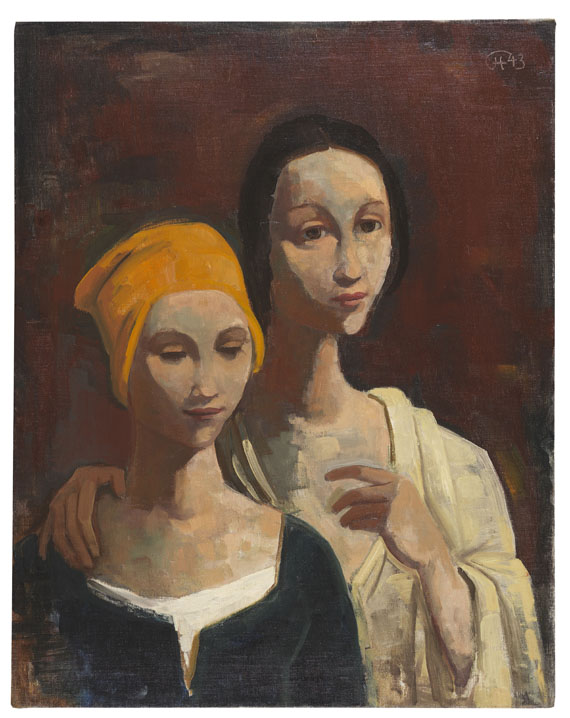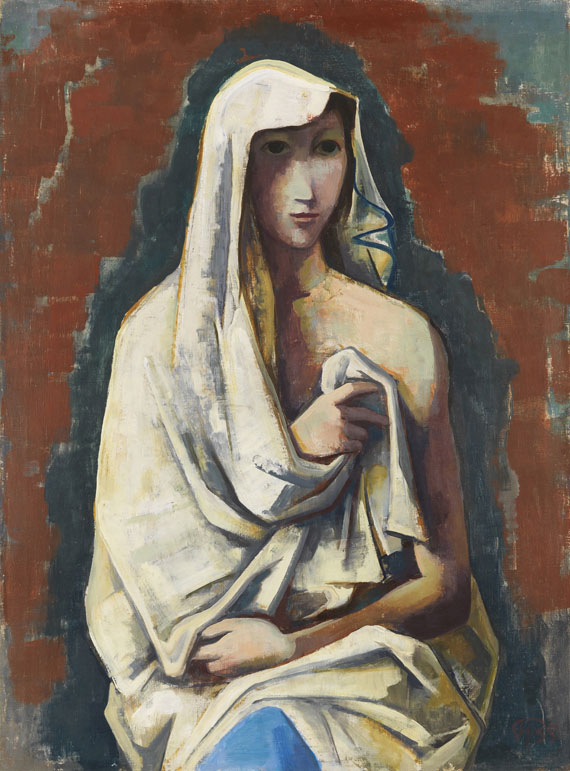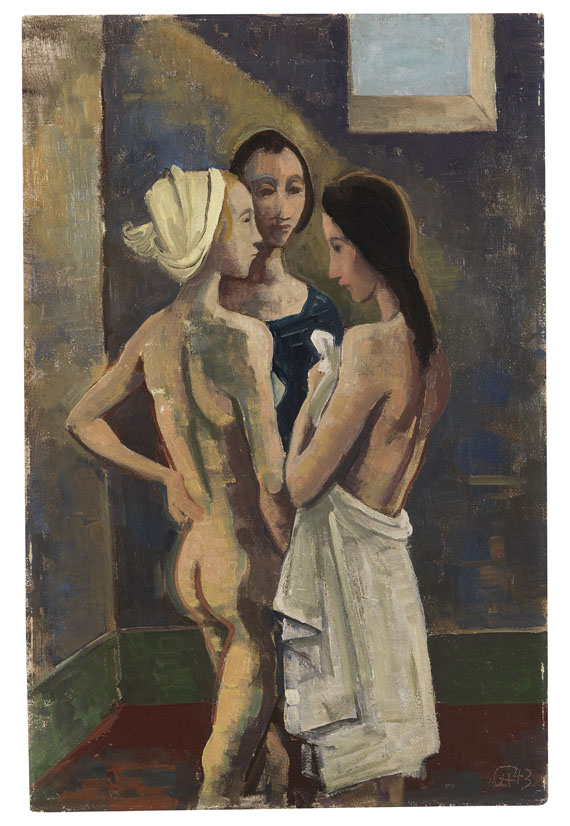Sale: 550 / Evening Sale, June 07. 2024 in Munich  Lot 124000020
Lot 124000020
 Lot 124000020
Lot 124000020
124000020
Karl Hofer
Zwei Frauen am Brunnen, 1940.
Oil on canvas
Estimate:
€ 150,000 - 250,000
$ 160,500 - 267,500
Information on buyer's premium, taxation and resale right compensation will be available four weeks before the auction.
Zwei Frauen am Brunnen. 1940.
Oil on canvas.
Lower right monogrammed (in ligature) and dated. 102.5 x 78.5 cm (40.3 x 30.9 in).
• Hofer's presentation of an enigmatic encounter and the symbolism he uses allow for political, historical, biographical and iconographic associations.
• Consistent provenance: acquired directly from the artist.
• Part of a private collection in the Rhineland for three generations.
• In 2022, part of the acclaimed exhibition "Kunst für keinen" at the Schirn Kunsthalle in Frankfurt am Main.
PROVENANCE: Private collection Rhineland (acquired from the artist in Berlin in 1940/41).
Ever since family-owned.
EXHIBITION: Kunst für keinen, Schirn Kunsthalle, Frankfurt am Main, March 4 - June 6, 2022, p. 290 (illu. on p. 179).
LITERATURE: Karl Bernhard Wohlert, Karl Hofer. Werkverzeichnis der Gemälde, vol. 2, Cologne 2008, no. 1482 (illu. in black and white).
"It is always gratifying to see a Hofer work believed destroyed in the war suddenly turn out to be in good condition."
Karl Bernhard Wohlert, author of the catalogue raisonné about the work offered here in a private letter from January 21, 2000.
Oil on canvas.
Lower right monogrammed (in ligature) and dated. 102.5 x 78.5 cm (40.3 x 30.9 in).
• Hofer's presentation of an enigmatic encounter and the symbolism he uses allow for political, historical, biographical and iconographic associations.
• Consistent provenance: acquired directly from the artist.
• Part of a private collection in the Rhineland for three generations.
• In 2022, part of the acclaimed exhibition "Kunst für keinen" at the Schirn Kunsthalle in Frankfurt am Main.
PROVENANCE: Private collection Rhineland (acquired from the artist in Berlin in 1940/41).
Ever since family-owned.
EXHIBITION: Kunst für keinen, Schirn Kunsthalle, Frankfurt am Main, March 4 - June 6, 2022, p. 290 (illu. on p. 179).
LITERATURE: Karl Bernhard Wohlert, Karl Hofer. Werkverzeichnis der Gemälde, vol. 2, Cologne 2008, no. 1482 (illu. in black and white).
"It is always gratifying to see a Hofer work believed destroyed in the war suddenly turn out to be in good condition."
Karl Bernhard Wohlert, author of the catalogue raisonné about the work offered here in a private letter from January 21, 2000.
Melancholy and “quiet beauty”. Hofer's figure paintings
“There is no doubt that Karl Hofer made his greatest accomplishment in figure painting”, wrote Dr. Frank Schmidt, former director of the Emden Kunsthalle, in the catalog for the 2012 exhibition “Karl Hofer. Von Lebensspuk und stiller Schönheit” (p. 92). The figure paintings were already part of the legendary exhibition “German Art of the 20th Century” at the Museum of Modern Art in New York in 1957, alongside works by Otto Dix and Max Beckmann, among others. Hofer's paintings are often classified as expressive realism, but in their almost austere clarity and orderly form, as well as the calm and stillness of the objects they contain, they are very close to the art of New Objectivity. With his timeless, withdrawn and yet gracefully melancholic depictions, Karl Hofer is one of the great loners of 20th century art. The artist always shows his mostly female protagonists in a moment of contemplation characterized by an elusive emotion, the source of which remains obscure to the viewer, as the painting itself provides no narrative.
Disaffection in society
In “Zwei Frauen am Brunnen” (Two Women at the Fountain), the artist shows two characteristic female “Hofer types” with almond-shaped eyes, pale complexion and pointed chins standing at a fountain that is supposed to be a connecting element, while Hofer uses it to highlight a boundary: a visual barrier that divides the scene and separates the figures from one another. Hofer moves the figures close to the picture's front edge, but despite their physical closeness, there is no sign of any exchange between the two women. The isolation and introversion of the figures is certainly partly due to Hofer's New Objectivity style, but is also a sensitive allegory of a generation of artists who remained in inner emigration due to the cultural policies of the National Socialists. This statuesque immobility, devoid of any emotions, makes for a clear contrast to the subtle, erotic sensuality of the almost naked sitter with a classical look on the right and the woman on the left, who appears quite modern for the time with her colorful and revealing clothes, looking demonstratively past her in a self-confident posture and a cool, almost frozen gaze.
Retrospection and modernity
The white cloth wrapped ingeniously around the figure on the right and the nudity shown only to some\~degree,\~allow an intimate atmosphere to unfold and create a subtle tension between unveiling and concealing. Hofer employs a trick from works of antiquity and Renaissance, which he was able to study in detail during his prolonged stay in Rome from 1903. His entire oeuvre reveals a deep interest in art history,\~to\~which he refers subtly but repeatedly. The headscarf that is so characteristic of his figures may be reminiscent of Pieter Bruegel the Elder,\~Hofer's\~women reading letters may be reminiscent of Jan Vermeer\~and\~his table parties call Dutch genre paintings to mind. The statuesque-sculptural contemplation and the\~figures'\~seemingly spiritual reverie may also have been inspired by art history, such as the donor figure of\~“Uta”\~in the Naumburg Cathedral, which Hofer explicitly mentioned in his remarks on universally valid formal language (cf. D. Kupper (ed.), Karl Hofer. Schriften, Berlin 1995, p. 114). The pictorial situation of the figures at the well is also a subject frequently found in art history, for\~example\~in biblical depictions such as\~“Rebekah at the Well”\~(also\~“Rebekah and Eleazar at the Well”)\~or\~“Christ and the Samaritan Woman”,\~painted by, among others, Nicolas Poussin (1648), Giovanni Domenico Tiepolo (1751, both at the Musée du Louvre, Paris) and Angelika Kauffmann (1796, Bavarian State Painting Collections, Munich).
In his writings on art theory, the term\~“selection”\~is used in this context: Hofer chose a motif from art history but did not follow it entirely, instead, he made it entirely his own - as is the case in the present work, where, typical of\~Hofer's\~style, the motif is not a traditional one. With the characteristic formal reduction to individual essential pictorial elements, highly modern motif accents, and the intrinsic introspection of\~Hofer's\~figures, the artist succeeds in translating the subject into his very own contemporary visual language and transforming it into a universally valid representation. His intention is always an artistic generalization, the depiction of a universally valid definition of the concept of beauty and a visualization of a mood: the melancholy of the years of hardship so familiar to him.
Escaping a tragic fate
“Two Women at the Fountain” was painted amidst the war in 1940, a devastating time for Karl Hofer both professionally and personally. Since the 1920s, he had held a professorship for painting at the 'Vereinigte Staatsschulen für freie und angewandte Kunst' in Berlin-Charlottenburg and was a board member of the Berlin Secession, as well as a member of the Senate of the Prussian Academy of Arts. His works were represented in around 30 German and international museums. In the 1930s, these successes and his established position within the German art scene were destroyed by the policies of the National Socialists. Hofer was dismissed and his art defamed. In 1937, eight of his paintings were shown in the propaganda exhibition “Degenerate Art” in Munich, and more than 300 of his works were removed from public collections in Germany. However, Hofer was able to continue his international success: in 1939, the Kunstmuseum Winterthur dedicated a comprehensive solo exhibition to him. In the same year, he was awarded the first prize by the jury at the International Exhibition of Paintings at the Carnegie Institute in Pittsburgh.
With the beginning of the Second World War, Hofer returned to Berlin from the Ticino, his adopted home at the time. The background of our painting shows the Ticino landscape he had to leave behind, it is frequently found in his landscapes made between 1926 and 1945. The vastness and emptiness between the landscape and the actual events in the foreground may reflect Hofer's very own personal situation: in these years, his beloved Ticino was a long way off, even in real life, and only accessible in thought and art. What remains is a yearning, painterly retrospective of an irretrievably lost past.
In 1943, Karl Hofer's Berlin studio and most of the paintings in it were destroyed in air raids. However, shortly after our work was created (1940 or 1941), “Zwei Frauen am Brunnen” ended up in the collection of a Düsseldorf industrialist with a keen interest in art and thus survived the destruction. Karl Bernhard Wohlert, the author of the catalogue raisonné of Karl Hofer's paintings (Cologne 2008), also expressed his delight about this fortunate coincidence. In a letter regarding the inclusion of the painting in the catalogue raisonné, which was in preparation at the time, he wrote in 2000: “It is always gratifying when a Hofer work that was thought to have been destroyed during the war suddenly turns out to be in good condition.” The former owner and his wife were killed by an air raid bomb in 1945. However, the painting remained in the family's possession for the following 70 years. In 2022, it was presented to a wider audience for the first time in the acclaimed exhibition "Kunst für keinen" at the Schirn Kunsthalle in Frankfurt am Main. A second, different version of our motif has been in the collection of the Staatliche Museen zu Berlin since 1952 (around 1940, Kupferstichkabinett). [CH]
“There is no doubt that Karl Hofer made his greatest accomplishment in figure painting”, wrote Dr. Frank Schmidt, former director of the Emden Kunsthalle, in the catalog for the 2012 exhibition “Karl Hofer. Von Lebensspuk und stiller Schönheit” (p. 92). The figure paintings were already part of the legendary exhibition “German Art of the 20th Century” at the Museum of Modern Art in New York in 1957, alongside works by Otto Dix and Max Beckmann, among others. Hofer's paintings are often classified as expressive realism, but in their almost austere clarity and orderly form, as well as the calm and stillness of the objects they contain, they are very close to the art of New Objectivity. With his timeless, withdrawn and yet gracefully melancholic depictions, Karl Hofer is one of the great loners of 20th century art. The artist always shows his mostly female protagonists in a moment of contemplation characterized by an elusive emotion, the source of which remains obscure to the viewer, as the painting itself provides no narrative.
Disaffection in society
In “Zwei Frauen am Brunnen” (Two Women at the Fountain), the artist shows two characteristic female “Hofer types” with almond-shaped eyes, pale complexion and pointed chins standing at a fountain that is supposed to be a connecting element, while Hofer uses it to highlight a boundary: a visual barrier that divides the scene and separates the figures from one another. Hofer moves the figures close to the picture's front edge, but despite their physical closeness, there is no sign of any exchange between the two women. The isolation and introversion of the figures is certainly partly due to Hofer's New Objectivity style, but is also a sensitive allegory of a generation of artists who remained in inner emigration due to the cultural policies of the National Socialists. This statuesque immobility, devoid of any emotions, makes for a clear contrast to the subtle, erotic sensuality of the almost naked sitter with a classical look on the right and the woman on the left, who appears quite modern for the time with her colorful and revealing clothes, looking demonstratively past her in a self-confident posture and a cool, almost frozen gaze.
Retrospection and modernity
The white cloth wrapped ingeniously around the figure on the right and the nudity shown only to some\~degree,\~allow an intimate atmosphere to unfold and create a subtle tension between unveiling and concealing. Hofer employs a trick from works of antiquity and Renaissance, which he was able to study in detail during his prolonged stay in Rome from 1903. His entire oeuvre reveals a deep interest in art history,\~to\~which he refers subtly but repeatedly. The headscarf that is so characteristic of his figures may be reminiscent of Pieter Bruegel the Elder,\~Hofer's\~women reading letters may be reminiscent of Jan Vermeer\~and\~his table parties call Dutch genre paintings to mind. The statuesque-sculptural contemplation and the\~figures'\~seemingly spiritual reverie may also have been inspired by art history, such as the donor figure of\~“Uta”\~in the Naumburg Cathedral, which Hofer explicitly mentioned in his remarks on universally valid formal language (cf. D. Kupper (ed.), Karl Hofer. Schriften, Berlin 1995, p. 114). The pictorial situation of the figures at the well is also a subject frequently found in art history, for\~example\~in biblical depictions such as\~“Rebekah at the Well”\~(also\~“Rebekah and Eleazar at the Well”)\~or\~“Christ and the Samaritan Woman”,\~painted by, among others, Nicolas Poussin (1648), Giovanni Domenico Tiepolo (1751, both at the Musée du Louvre, Paris) and Angelika Kauffmann (1796, Bavarian State Painting Collections, Munich).
In his writings on art theory, the term\~“selection”\~is used in this context: Hofer chose a motif from art history but did not follow it entirely, instead, he made it entirely his own - as is the case in the present work, where, typical of\~Hofer's\~style, the motif is not a traditional one. With the characteristic formal reduction to individual essential pictorial elements, highly modern motif accents, and the intrinsic introspection of\~Hofer's\~figures, the artist succeeds in translating the subject into his very own contemporary visual language and transforming it into a universally valid representation. His intention is always an artistic generalization, the depiction of a universally valid definition of the concept of beauty and a visualization of a mood: the melancholy of the years of hardship so familiar to him.
Escaping a tragic fate
“Two Women at the Fountain” was painted amidst the war in 1940, a devastating time for Karl Hofer both professionally and personally. Since the 1920s, he had held a professorship for painting at the 'Vereinigte Staatsschulen für freie und angewandte Kunst' in Berlin-Charlottenburg and was a board member of the Berlin Secession, as well as a member of the Senate of the Prussian Academy of Arts. His works were represented in around 30 German and international museums. In the 1930s, these successes and his established position within the German art scene were destroyed by the policies of the National Socialists. Hofer was dismissed and his art defamed. In 1937, eight of his paintings were shown in the propaganda exhibition “Degenerate Art” in Munich, and more than 300 of his works were removed from public collections in Germany. However, Hofer was able to continue his international success: in 1939, the Kunstmuseum Winterthur dedicated a comprehensive solo exhibition to him. In the same year, he was awarded the first prize by the jury at the International Exhibition of Paintings at the Carnegie Institute in Pittsburgh.
With the beginning of the Second World War, Hofer returned to Berlin from the Ticino, his adopted home at the time. The background of our painting shows the Ticino landscape he had to leave behind, it is frequently found in his landscapes made between 1926 and 1945. The vastness and emptiness between the landscape and the actual events in the foreground may reflect Hofer's very own personal situation: in these years, his beloved Ticino was a long way off, even in real life, and only accessible in thought and art. What remains is a yearning, painterly retrospective of an irretrievably lost past.
In 1943, Karl Hofer's Berlin studio and most of the paintings in it were destroyed in air raids. However, shortly after our work was created (1940 or 1941), “Zwei Frauen am Brunnen” ended up in the collection of a Düsseldorf industrialist with a keen interest in art and thus survived the destruction. Karl Bernhard Wohlert, the author of the catalogue raisonné of Karl Hofer's paintings (Cologne 2008), also expressed his delight about this fortunate coincidence. In a letter regarding the inclusion of the painting in the catalogue raisonné, which was in preparation at the time, he wrote in 2000: “It is always gratifying when a Hofer work that was thought to have been destroyed during the war suddenly turns out to be in good condition.” The former owner and his wife were killed by an air raid bomb in 1945. However, the painting remained in the family's possession for the following 70 years. In 2022, it was presented to a wider audience for the first time in the acclaimed exhibition "Kunst für keinen" at the Schirn Kunsthalle in Frankfurt am Main. A second, different version of our motif has been in the collection of the Staatliche Museen zu Berlin since 1952 (around 1940, Kupferstichkabinett). [CH]
124000020
Karl Hofer
Zwei Frauen am Brunnen, 1940.
Oil on canvas
Estimate:
€ 150,000 - 250,000
$ 160,500 - 267,500
Information on buyer's premium, taxation and resale right compensation will be available four weeks before the auction.




